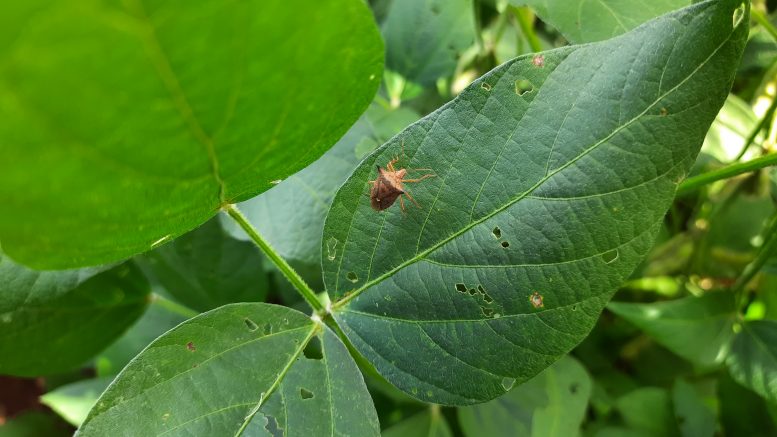“In soybean, these pests cause pods to fall, grain failure, and affect the quality of grains and seeds.”
Germison Vital Tomquelski is a phytosanitary researcher at Desafios Agro, agronomist, M.Sc and Ph.D in agronomy from Universidade Estadual Paulista.
Tomquelski was a researcher in charge of the entomology and weeds sector at Fundação Chapadão, and professor of entomology and acarology at the Universidade Estadual do Mato Grosso do Sul.

Germison Tomquelski, phytosanitary researcher at Desafios Agro
AgriBrasilis – Why have phytophagous Heteroptera bugs, previously considered secondary pests, become the most important pests for soybean and corn farming?
Germison Tomquelski – Several factors can be pointed out, but we can highlight some fundamental ones:
- The production system has intensified in the various producing regions. Consequently, the pest underwent adaptations both in relation to crops (soybeans, corn, cotton, beans, etc.), as well as in alternative hosts, such as weeds. Populations grew after each season.
- After 2015, the entry of Bt technology in soybean cultivation also led to a decrease in insecticides, that were applied in the vegetative phase of the crop, and had a certain effect on the beginning of insect colonization. Without these insecticides, the pest increased its infestation in the crop “earlier”, causing larger population outbreaks at the end of the crop.
- There have also been changes in the species that have been growing in infestation, as is the case of the green belly bug, that is widely adapted to various weeds. Consequently, the bug “remains” more in the production system, for example.
AgriBrasilis – What are the most relevant species of these bugs and why? How can they be detected?
Germison Tomquelski – Among the most widespread species in the system are the brown stink bug (Euschistus heros) and the green-belly stink bug (Diceraeus sp.). These pests are widely adapted, often being native to the different regions.
Detection occurs with visual assessments, at the beginning of the crop development, or with the use of a beating cloth (white cloth placed between rows): when the plants are shaken, the insects fall on this cloth and are counted. This strategy is essential for soybean, when the plants are in the reproductive stage, in order to account for the presence of nymphs.
The mentioned pests present uneven distribution. Therefore, the representativeness in the samples is fundamental for the management (farm’s borders – patches of weeds can have larger populations).
Another strategy under development is pheromones, that can help in the vegetative phase. For the green-belly stink bug in corn, the use of baits can help to count the insects.
AgriBrasilis – What are the losses and injuries caused by these pests and what are the control alternatives?
Germison Tomquelski – The losses are enormous. These pests can generate up to 100% failure, causing anomalies in soybean plants (crazy soybean 1 – leaf retention). The losses normally seen in these cases are decreases in the order of 5% to 30% of crop failure.
In soybean, these pests cause pods to fall, grain failure, and affect the quality of grains and seeds. In corn, they can cause abnormalities in the plants, that will need to be re-sown, because of toxins and damage to the growth of the plants.
Control strategies include good monitoring, identification of the pest and the use of chemical, biological and cultural control strategies, among others, in an integrated manner. Chemical control is widely used in Brazil, with efficiencies of around 80% to 90% of control.
New insecticides are expected to manage this pest, that may arrive in the 2023/24 season, along with crop rotation, in addition to new integrated strategies.
AgriBrasilis – Another novelty for integrated pest management is the population growth of the Rachiplusia caterpillar in soybean. Why did this phenomenon occur? What are its impacts, in which productive regions?
Germison Tomquelski – Rachiplusia nu is a pest that occurred after the advance of Intacta soybean in Brazil. In the main producing regions, its infestation has increased, selected by Bt 1 (Intacta) technology, since it was not the target of this control.
Today, this pest is found in states such as Paraná, São Paulo, Minas Gerais, Goiás, Mato Grosso do Sul, Mato Grosso. It is also in other states, but with a smaller population. It is a defoliating pest, like Chrysodeixis includens, that until 2015 was the main soybean pest.
Rachiplusia nu can generate losses of up to 30%, a rate verified by the researchers of Desafios Agro, and it is important to monitor it and, if necessary, to adopt management measures.
For chemical control, some tools already stand out: active ingredients such as emamectin benzoate, indoxacarb and chlorfenapyr.
AgriBrasilis – At the end of 2022, you warned about the pressure of caterpillars of the genus Helicoverpa on GMO soybean farms. Is this situation expected to continue in 2023?
Germison Tomquelski – The occurrence of Helicoverpa in Brazil during the 2012/13 and 2013/14 seasons was one of the highest ever detected. This number has greatly decreased, but in some places and in certain years population spurts can occur. The farmer must pay attention to monitoring.
These outbreaks can occur in a given region in one year and decrease in the following year, and can even change during the agricultural year, occurring at the beginning or at the end of the harvest, for example. This question is related to the management adopted regionally (insecticides x natural enemies), being an important point of analysis.
Because of the destructive potential, Helicoverpa is a pest that cannot be underestimated, and can lead to great damage in several cultures.
AgriBrasilis – What is the status of the break in resistance of BT soybean varieties? Is the technology obsolete?
Germison Tomquelski – The Bt cultivars have suffered from the process of breaking resistance or even from the occurrence of secondary pests, that were not the target of these technologies.
About soybean, we can say that Bt cultivars are not obsolete. They have worked well for some targets, for example in the case of the species Chrysodeixis includens, that until 2015 was the main pest in this crop. However, the occurrence of other pests, previously considered secondary, has led the farmer to carry out applications to control them. The concept of “pest shift” is very important, because one pest has given way to another.
It should be noted that biotechnology, together with breeding, has led the farmer to achieve greater productivity. Bt technology is important in the current scenario.
AgriBrasilis – What is the work developed by the Desafios Agro Consultancy?
Germison Tomquelski – Over the last three agricultural seasons, we have carried out management work for most of the pests that affect soybean, corn and cotton, including chemical, biological, attractant and pheromonal control work, among others.
We seek to bring innovation to the farmer, safe alternatives, with less impact on the environment and better cost-benefit ratio.

Nymphs of brown stink bug (Euschistus heros)
READ MORE:

